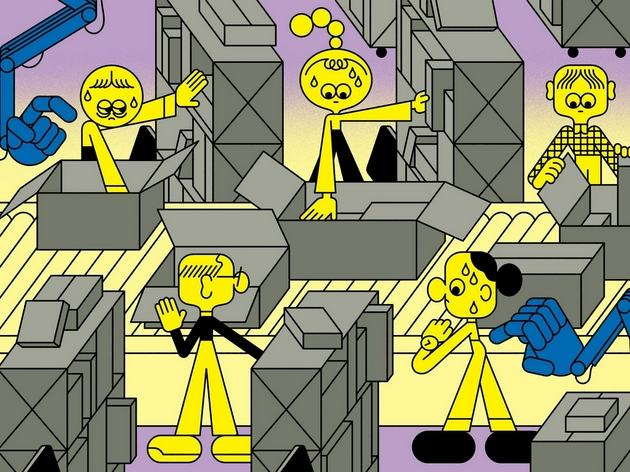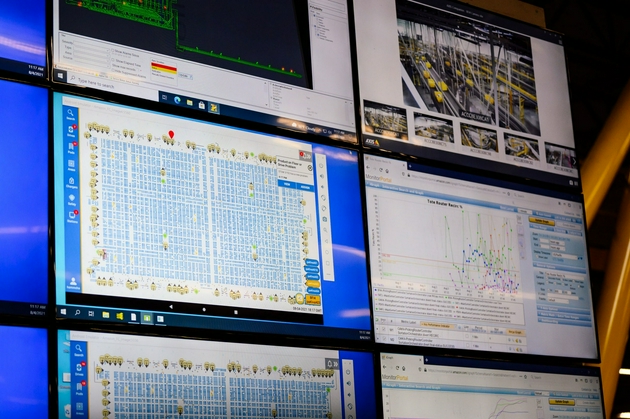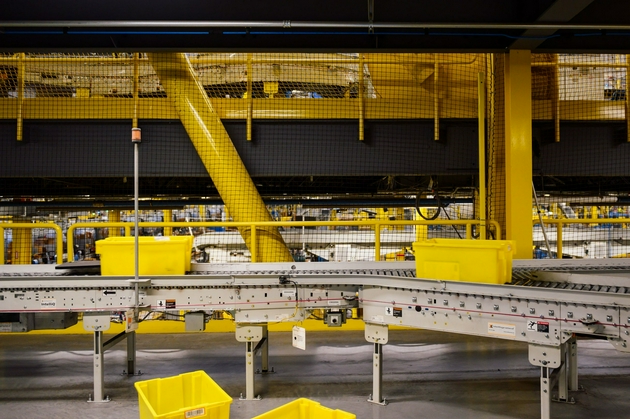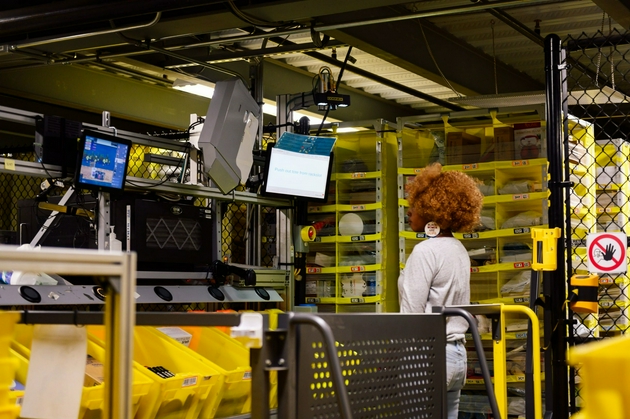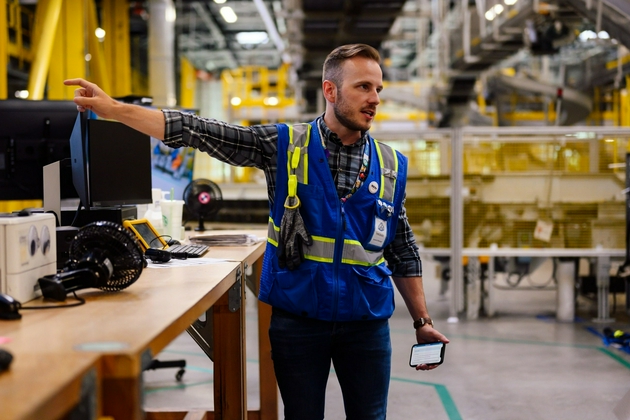Compiled by/Yong Yan
Amazon Evan Shobe, the general manager of the department, sat in front of nine computer screens in the company's empty performance center. This command center is internally called the "quarterback table" (QB). The performance center covers an area of about 15 football fields, and complex operations are monitored in this command center.
The dense blue dots represent the robots transporting products; The yellow pattern, which looks like a toilet sign, represents the human who loads and unloads goods for robots. The intricate green lines represent the process in which the conveyor belt quickly transmits orders to various stations on the production line and finally to delivery trucks.
BFI4, located in the suburb of Kent, Washington, is a flagship performance center of Amazon. In addition to delivering products, it is also used to regularly receive company executives. Andy Jassy, the new CEO, recently came here. Executives want to know the workflow of the performance center after the buyer places an order.
This is the first facility of Amazon that can handle more than 1 million goods every day. Ten years ago, the company's most advanced warehouse handled only one third of the goods now. The continuous leap of technology makes Amazon take the lead Wal-Mart 、 Target (American retail company) and other friends. These competitors are now following many of Amazon's practices over the years.
Algorithm: magic weapon of efficiency leap
The core of this facility is not a physical robot, but the algorithm behind it - a set of computer instructions designed to solve specific problems. The software can solve many problems in the process of warehouse operation: the quantity of goods handled by a single facility, the location of goods, the night shift manpower required in holiday peak hours, and the most suitable distribution trucks. Xiao Bo, general manager of BFI4, said: "The algorithm has made many correct decisions for us."
The high degree of automation enables the supervisors of each performance center to manage dozens of employees. This factory style operation has also become the industry standard. According to the data of the US Bureau of Labor Statistics, in 2012, a logistics warehouse manager supervised about 10 front-line workers. In 2020, after Amazon became the largest employer in the industry, this number almost doubled.
Such high efficiency naturally attracted many eyes, and competitors began to follow suit.
Although automation has improved efficiency, it has also attracted many criticisms. Critics are dissatisfied with the working conditions of Amazon hourly workers. Amazon's algorithm tells workers what they should do in the warehouse, sets productivity targets for them, and marks unqualified employees. An employee said in an interview that he felt like a gear embedded in a giant machine. The company "took the gear off" to drive it away, and only needed to send an email.
Amazon also admitted that this algorithm is not perfect. Amazon said that most automated processes in its facilities allow human supervision or intervention. Managers said that with strong software support, they can complete more work, and the company continues to improve its business processes.
Maju Kuruvilla, the engineering director who left last year, said that Amazon had noticed a few years ago that managers were sometimes just "a face hiding behind a computer". Kuluvira said: "The manager of the performance center seldom contacts with the employees. When the care of the employees is poor to a certain extent, it is the time when the workers want to establish a trade union."
A big chess game played by Bezos
When Jeff Bezos was just a bookseller, he began to think about replacing labor with software. In a famous story in the early days of Amazon, book reviews and recommendations previously completed by editors were replaced by code. The same work used to cost manpower, but now it can only be achieved by code mining shopping patterns.
Similar programs are then used to manage many aspects of Amazon's daily operations, such as ordering, placing inventory, monitoring the online market, and so on.
Bezos played a long game of chess. He bet that the algorithm could handle some tasks more efficiently or stably than manual work.
In the middle of last century, Amazon regarded automation as the focus of large-scale expansion of its packaging, transportation and delivery departments. Amazon logistics experts will reflect on their resumes the experience of "reducing the cost of single product transportation by a few cents".
In 2012, Amazon acquired Kiva Systems, an American automated robot manufacturer. Amazon hopes to use Kiva to replace manual sorting of goods, which requires large-scale redesign of the performance center.
BFI4, which was put into operation in 2016, is one of the first facilities specially built for small robots. 3500 employees and 110 managers are working in this assembly line factory under the "monitoring" of an accurate tracking system.
The workers push the mobile conveyor belt behind the truck carrying the inventory and feed the product into a system. The system will automatically scan the incoming items, and then hang them on Amazon's website for sale. After the goods are sold, the system will pay the supplier. After the goods are purchased by users, the workers stack the goods on the shelves. The shelves are closely arranged in the special area for robots. After an order is placed, Kiva will send the shelves to a picking station where workers will select appropriate products, put them into a barrel, and send them to the next area for packaging and shipment.
In the past, managers relied on Excel and intuition to calculate the manpower required for each site. However, from around 2014, the statistical data of Amazon's warehouses will be transmitted to the Seattle headquarters for processing and automation by software engineers.
David Glick, a former head of Amazon logistics who oversaw the initial development of the software, recalled that engineers had developed a program called AutoFlow. At first, this software was not feasible, because it would make the judgment of arranging 0.5 employees.
In the spring of 2019, Amazon executives instructed employees operating BFI4 to adopt AutoFlow's suggestion, which was refreshed every 15 minutes. If managers find that the system instruction is wrong, they can not follow the instruction form, but in most cases, managers are asked not to interfere.
Xiao Bo, who was in charge of the warehouse and transportation department at that time, said, "At first, we asked to allow the program to make mistakes and let it learn from it. Our team operation at that time was far better than the software, so this decision was really hard to understand at that time."
At first, AutoFlow always overreacted to demand changes, which would make workers quickly move to new positions and return to their previous positions a few hours later. This task allocation method not only consumes workers' energy, but also wastes time.
However, it is also constantly updated and becomes better and better. Amazon doesn't need to send people to check faults in every warehouse today. The operation of all warehouses can be monitored in front of the office computer.
Engineers have also created other ways to improve operational efficiency and accuracy. In the past, workers had to scan the barcode to know where the goods should be placed on the shelf. Now, the video camera can automatically identify the goods and send a green light beam to judge where they should be placed.
The epidemic brought a major challenge to Amazon. At that time, Americans had to isolate themselves at home, and shopping was basically online. In the severe environment, Amazon has also recruited 400000 new workers, which is inseparable from the participation of automation. Amazon uses programs to screen unqualified job seekers from a large number of resumes, uses video applications to train new employees, and relies on software to guide new employees to complete simple and repetitive tasks. Automation has become a ready to use labor force for engineers, and can be adjusted immediately when the situation changes.
"Devil's Factory"
Amazon's high-tech assembly line has made the company more efficient, but it has made employees miserable. Last year, workers in a warehouse in Alabama tried to form a labor union, but failed. The workers complained that they were forced to work with unreasonable goals, which were recommended by the algorithm.
A worker who has worked in Chicago for a long time said that the manager's most common guidance to him is to "speed up, speed up, speed up". For the same task, if the completion time is two seconds faster than the average time, it will be praised by the manager and warned if it is two seconds slower. The employee asked for anonymity because he was not authorized to accept media interviews.
In September, the California legislature passed a bill that would give warehouse workers the right to fight against the so-called speed quota. Supporters of the bill said that the oversaturated work rhythm forced employees to avoid safety rules and give up rest time. The governor of the state has not signed the bill.
An employee who joined the Nevada warehouse in the large-scale recruitment tide of Amazon recalled that he was really worried about the collapse of the shelves when he saw colleagues piling goods on the shelves. The employee, who did not want to reveal his identity, said: "In order to make the performance look good, even security cannot be guaranteed, and he always feels under great pressure."
Washington state regulators fined an Amazon warehouse in DuPont earlier this year. The regulator said there was a direct link between the facility's fast pace of work and injuries. Amazon is appealing against the fine, saying it is modifying its productivity tracking tool to better solve the problems faced by employees.
Many workers receive work tasks through computers or mobile phones all day long. They say this environment makes people feel isolated from their colleagues. Many front-line workers said in an interview that they often could not name the manager, and it was not easy to establish relations with colleagues. This situation was even worse under the epidemic. Xiao Bo was frustrated by such criticism. He suggested that new employees still try to get to know everyone and socialize actively.
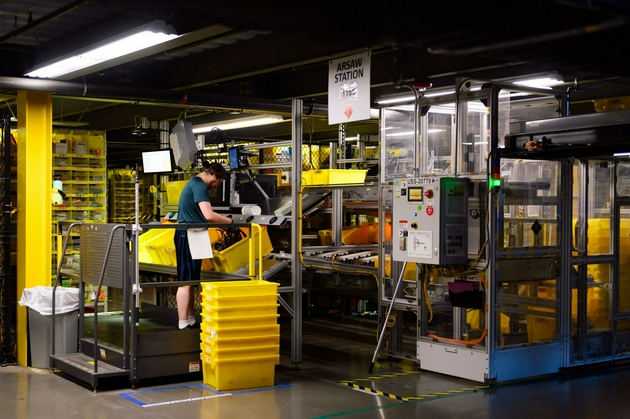
Responsible for the front of the team of Amazon Performance Center general motors Alicia Boler Davis, an executive of the company, believes that higher levels of automation can free up time for managers to have more contact with workers. She said: "I hope managers can spend time understanding employees and ensuring safety. What I think is how we can reduce the burden? Our goal is to simplify the work process, reduce the difficulty of work, and reduce the need to simplify the process to make decision-making easier, but also to reduce the physical burden and let employees deal with some other tasks."
The reputation of Amazon's "Devil's Factory" made people who built businesses for the company dissatisfied. A former Amazon employee who was once responsible for developing warehouse technology said: "Amazon is not inhuman, nor does it mean to abuse employees. It's just that when concentrating on solving mathematical problems, someone really needs to remind you that work arrangements need to consider humanistic care."
Not only front-line workers are trapped in the algorithm, but Amazon's managers are also constrained everywhere. A warehouse manager in Oregon said that he really wanted to know more about the hundreds of employees who reported to him, but time pressure made him busy working all day and unable to discuss career goals with employees. He said that he hardly had the option of "rest". The manager left Amazon last year because he signed a confidentiality agreement and asked to remain anonymous. He said that after a 12 hour shift, he occasionally took a nap in the car to avoid being too sleepy to drive on the way home.
But Amazon says these are not common phenomena. In July, it announced that it would take employee benefits as one of its guiding principles, and promised to become the best and safest employer in the world. Amazon recently said that it will spend 1.2 billion dollars (about 7.756 billion yuan) to provide courses and job training for front-line workers, and will also reimburse some employees for college tuition.
Xiao Bo believes that new employees will be better trained to understand their promotion channels in Amazon. He said: "Not everyone can find their own development path in the performance center. We have to take the initiative to attack employees, such as telling them, 'There is a new device here, if you are interested, I can teach you how to use it'“
What kind of future will the industry benchmark lead?
Amazon assembly line has attracted other enterprises in the logistics industry to follow suit. "Amazon is the industry benchmark, far ahead." said Greg, former logistics director of Amazon, who is now CEO of Flexe, a warehousing startup.
Wal Mart, Amazon's No. 1 rival, is also introducing highly automated warehouses to existing stores. American chain grocery retail giant Kroger (Kroger Co.) is trying to build a robot warehouse for grocery distribution. Instacart Inc., the second largest unicorn in the United States, has established its own grocery distribution business through a robot army, and the company is building its own robot warehouse.
Even small enterprises like Cargo Cove feel that they can match the automation efficiency of Amazon. Cargo Cove is a storage startup with only 80 employees, which has been established for 4 years. The company is planning to introduce robots and software in the coming months to automatically route orders and monitor employee output. Robert McFaul, founder of Cargo Cove, said: "This is the same principle as Amazon, which is to establish a very simple standardized process."
Back at BFI4 warehouse, Xiao Bo was walking along the corridor quickly, watching the workers untie a yellow suitcase commodity stuck on the conveyor belt. He clicked several keys on an application program to record when the stuck place was cleaned up. This is a security inspection that he needs to carry out regularly to reduce the number of injuries in the warehouse.
Amazon's technical team has a long-term goal - to establish a fully automated performance center without human intervention. This desire will take several years. The current challenge is to let the robot arm grasp objects of different sizes and textures. Amazon executives said that in the foreseeable future, human resources are still essential.
Amazon engineers are currently studying how to move more products in each warehouse to further improve product delivery speed, which is undoubtedly good news for customers.
However, the employees are afraid that they will get cold again, and they don't know when they will be able to fly out of the fence of machines and algorithms.
